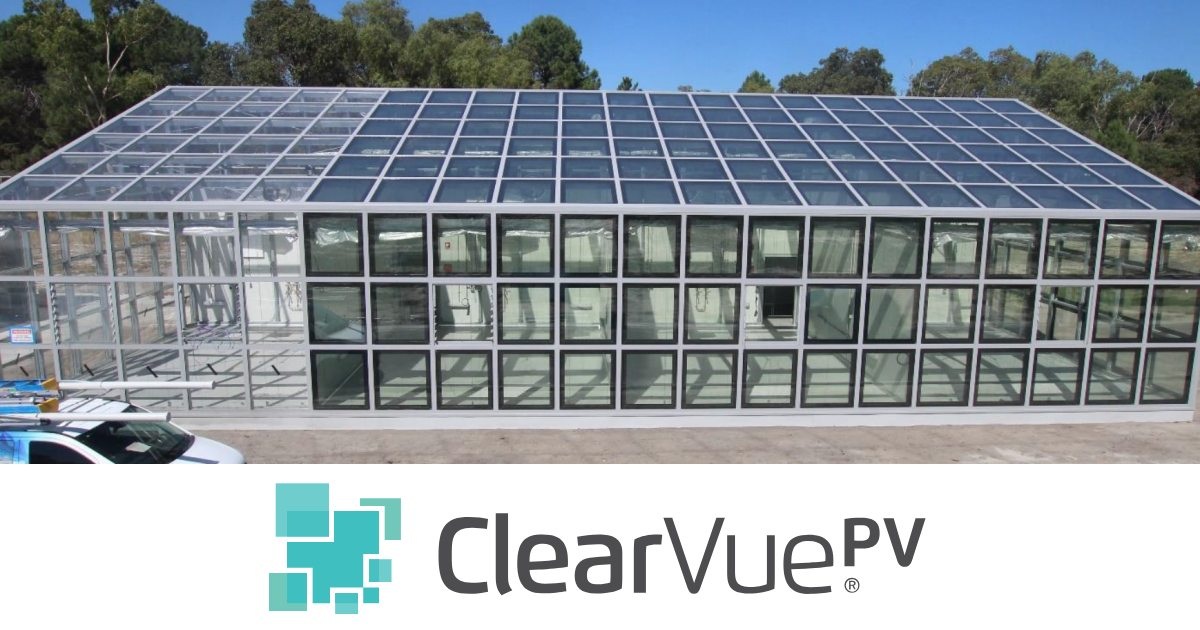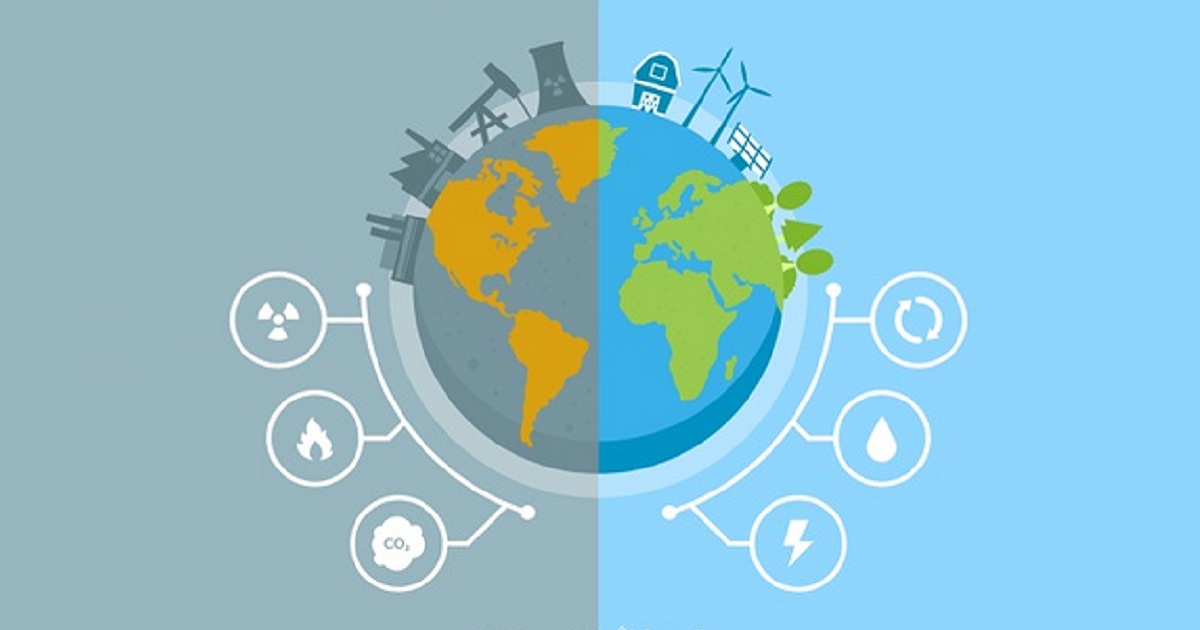
Solar+Storage
Article | June 14, 2022
A high-tech greenhouse comprised mainly of solar glass generating electricity to help run it was officially opened yesterday in Western Australia.
ClearVue Technologies Limited’s solar glass involves a nanoparticle interlayer and spectral-selective coating on the rear external surface that enables 70% of natural light to pass through while redirecting infrared and UV light converted to infrared to the edge where it is harvested by solar cells. ClearVue says each 1m2 of its window product is currently rated to generate 30 watts-peak of electric power, but also mentions a new-generation product with the proven ability to generate 40 watts peak per m2 to be available sometime this year.
Read More

Solar+Storage, Strategy and Best Practices
Article | September 17, 2022
Energy is an important feature in the economic and political development of a country. In developed nations like the USA, energy expansion has now reached a point where renewable energy sources also play a large part in the production of electricity.
To meet the energy demands of the country, most production of renewable energy comes from fossil fuels and other non-renewable energy sources.
Around 25% of the world’s energy is generated with renewable energy resources- mainly solar, wind, hydropower, and in some cases, geothermal. It is one of the fastest-growing electricity sources.
Renewable energy is collected from resources that are abundantly available in the environment, like the sun or wind. There has been a growing interest in renewable energy production as fossil fuels are depleting. In most parts of the world, renewable energy has become a primary source of energy production.
Renewable energy is preferred as they produce fewer greenhouse gases than non-RE sources. There are several other advantages to renewable sources like lower carbon emissions, reduced air pollution, and other socioeconomic benefits.
However, unlike non-RE sources, there are challenges in renewable energy like economic, political and regulatory barriers, structural, social, and technical challenges which require advancement in technology, and a heavy investment with a proper understanding of obstacles it faces. Some obstacles are due to technology associated with renewable energy, whereas others are because of policies, marketplace, regulations, and infrastructure.
Impact of Covid-19
The Covid-19 pandemic has brought the world to a grinding halt. It has severely impacted individuals and businesses alike, with many of the latter being closed down permanently. Similarly, the pandemic has also impacted the expansion of clean energy systems by forcefully curbing any investments.
The technology and adoption of renewables have been making uneven but sure progress. The global pandemic has slowed down this development. According to International Energy Agency, the global share of electricity supply from renewables had reached 28% in 2020 from 26% in 2019, but the growth is expected to slow down further. The total energy supply is set to reduce by 13% from 2019. This substantial decline can be attributed to supply chain disruptions, lockdown, and emerging financial problems. Transport biofuel production and renewable heat consumption are projected to decline due to lower industrial activity.
Governments have an opportunity to promote and accelerate the use of clean energy by incentivizing building, technology, and infrastructure across the country. This would be crucial to rebuilding the economy, create jobs, and build efficiency.
Capital Costs and Investment
The most obvious challenge of widespread adoption of renewables is cost, predominantly infrastructure costs like building and installing solar and wind power plants. Although it is quite cheap to operate and maintain solar and wind power plants, installation becomes more and more expensive.
Over the last few years, even though the prices of installation of solar panels has fallen significantly, it remains higher than non-renewables. On average, a 2-kilowatt solar panel system costs $4,159 after tax credits, whereas the capital cost of a gas-fired power plant would cost lesser than that.
In the last two years, investment in renewables has increased, but that is only because the investments in fossil fuels have been rapidly falling. Clean energy investments still fall short of what is necessary to convert into a more sustainable future. To ensure continuous investment in sustainable energy, policymakers have to focus on short investment turnaround, focus on rapid environmental gains favoring cleaner energy generation.
Power on demand
One of the most significant challenges of renewables is the ability to provide power on demand. In the case of solar power, you only get energy during the day and only when it is sunny. As for wind energy, power is generated only when it is windy. There is an intermittent generation of power in renewables which wouldn’t be a problem if there were appropriate energy storage solutions. The biggest test in providing power on demand is storage. Even if homes, businesses, or states install wind energy systems or solar panels, storing the generated energy is still an unsolved issue.
Opponents of renewable energy highlight the reliability factor on solar and wind to augment support for coal, gas, and nuclear plants, which provide baseload power. This argument is used by lobbyists to drive out investment into renewables, thus becoming a barrier to widespread adoption of wind and solar energy.
Location challenges
Renewable energy plants have grids that require a large area of land. It can be unappealing to customers to switch to renewable energy sources as it is conditional depending on the size of the land. Not all states and regions are apt to build solar panels or have wind turbines as they are dependent on the geographical location. For example, building solar panels in California makes more sense than building them in New York as the former has an abundant supply of both sun and land.
Renewables operates on what is known as a decentralized model. In a decentralized power plant, small generating stations are spread across a larger area that works collectively to deliver power. In the case of coal, nuclear power, or natural gas, they are highly centralized and depend on fewer high output power plants.
Siting
Decentralized systems prove to be a problem for siting and transmission of energy created by solar or wind. Siting is needed to move blades or solar panels to large pieces of land. To do so requires to draw up contracts, negotiate, acquire permits, or build community relations; all of this can delay or kill a renewable project even before it begins.
Businesses can incur additional charges due to demand and delivery which seems like a significant challenge for them. Utility services apply these charges to recover costs of purchasing energy and maintaining power lines and energy lost in the transmission system. Moving power sources closer to your business will help you avoid such preventable expenses.
Transmission
The next challenge to overcome in renewables is the transmission of generated electricity. Transmission means the transfer of electricity from where it is generated to where it is consumed. Most transmitters that exist in this day and age are built for coal and other fossil fuels and not renewables. To make things easier for transmission of clean energy, there needs to be a significant infrastructure and technological development, which cost a lot of money.
Making the economics work with financing and siting can prove costly for developers and customers alike.
Policies and Regulations
Unfortunately, the fossil fuel industry is backed by multi-billionaires who wield a considerable amount of political influence. This severely affects the chances of expansion for the renewable industry. Industry experts estimate that the USA spends upwards of $60 billion on subsidies for fossil fuels every year. The taxpayers have helped fund the industry’s research and development, drilling, mining, and generation of electricity. Renewables like wind and solar enjoy much lesser subsidies and political backing. The fossil fuel industry has used its enormous power to spread misinformation about climate change.
To increase public interest and investment in renewables, there need to be clear and concise legal procedures and regulatory policies. Having proper regulations in place creates a stable environment for investment and overcome hurdles and can anticipate the revenue streams. Large-scale renewable energy projects require a large amount of capital which is hindered by the failure of proper policies that fail to attract private players.
Frequently Asked Questions
What is a major challenge with using more renewable energy?
Renewable energy is competing with fossil fuels and nuclear technology. Other major challenges include underdeveloped infrastructure and lack of economies of scale.
What are the benefits of using renewable energy?
Some benefits of using renewable energy are lower energy costs, reduction of emissions, massive positive impact on environment, and marketing opportunities for businesses.
Is renewable energy cheaper than fossil fuels?
Fossil fuels are subsidized which makes it cheaper at the beginning. However, renewables get cheaper to maintain over the years hence making it cheaper than fossil fuels.
What is the cheapest source of renewable energy?
Solar PV and on site wind are the cheapest sources of renewable energy sources.
{
"@context": "https://schema.org",
"@type": "FAQPage",
"mainEntity": [{
"@type": "Question",
"name": "What is a major challenge with using more renewable energy?",
"acceptedAnswer": {
"@type": "Answer",
"text": "Renewable energy is competing with fossil fuels and nuclear technology. Other major challenges include underdeveloped infrastructure and lack of economies of scale."
}
},{
"@type": "Question",
"name": "What are the benefits of using renewable energy?",
"acceptedAnswer": {
"@type": "Answer",
"text": "Some benefits of using renewable energy are lower energy costs, reduction of emissions, massive positive impact on environment, and marketing opportunities for businesses."
}
},{
"@type": "Question",
"name": "Is renewable energy cheaper than fossil fuels?",
"acceptedAnswer": {
"@type": "Answer",
"text": "Fossil fuels are subsidized which makes it cheaper at the beginning. However, renewables get cheaper to maintain over the years hence making it cheaper than fossil fuels."
}
}]
}
Read More

Strategy and Best Practices, Industry Updates
Article | August 16, 2022
According to a survey from Consumer Reports, 76% of Americans believe that expanding renewable energy is a worthwhile goal.
People are interested in renewable energy, but finding those people and turning them into customers is challenging.
That’s where lead generation for renewable energy can help. You need smart lead generation strategies to grow your business and get customers access to renewable energy.
To discover the top strategies for lead generation for renewable energy companies, keep reading!
WebFX is a top lead generation agency, and our team of more than 200 digital marketing experts has generated more than 6.3 million leads for our clients over the past five years. Contact us online or at 888-601-5359 to learn more about our lead generation services.
Read More

Solar+Storage, Strategy and Best Practices
Article | September 17, 2022
“With Great Power Comes Great Responsibility”
– Voltaire (François-Marie Arouet)
We, humans, had completely buried this quote until it was brought back to life recently. Business leaders should remember this quote as it perfectly fits into the environmental-business perspective that we are presently facing.
If the world has to tackle the problem of climate change or come even close to achieving that goal, businesses and industries will have to play a key role. Almost a quarter, or 23% to be precise, of greenhouse gas emissions in the United States, come directly from industries. This number rises to 29.6% if we combine indirect emissions too.
When looking for causes of climate change, the private sector is often linked to. Minimizing your carbon footprint appears to be the year's buzzword, but where can businesses begin with such an ambiguous task? How do we assess progress? Peter Drucker wrote the premise of an answer back in 1954: "What gets measured, gets managed."
If a business really wants to become more sustainable, the first step should be to try to understand its current situation and begin tracking its carbon emissions. Measuring carbon emissions is a difficult problem. Major businesses that do not have carbon monitoring and reduction programs have become the exception.
Recognizing and measuring CO2 emissions aids in the identification of excessive energy consumption and other inefficiencies. Most of the time, lowering greenhouse gas emissions goes hand in hand with making a business's processes more efficient and cost-effective.
Reducing Greenhouse Gas Emissions: What Do Businesses Gain?
In addition to the long-term environmental benefits that will help us in saving our planet, organizations can also benefit from the positive impacts of greenhouse gas emission reduction. Some of the top benefits of effective emission management are as follows.
Cost Saving
When it comes to cost reductions, simply minimizing your energy consumption reduces both your organization's carbon footprint and its operating expenses. According to a 2016 Energy Star report, the owner of Kimberly-Clark Berkley Mill invested $350,000, which generated yearly savings of $160,000 and a rapid return on investment (ROI) of just over one and a half years when LED lighting was installed to replace the fluorescent and HID lighting that was traditionally used.
Regulatory Compliance
With a 20-fold rise in global climate change regulations since 1997, securing proactive regulatory compliance is much more important than ever in the minds of corporate leadership, public spheres, and stakeholders – and it's only becoming more important. Adopting an effective greenhouse gas emission reduction program, as well as tracking and reporting on progress, is essential for businesses to adopt in order to maintain operations and avoid penalties.
Improved External Relations
Consumer spending power has an enormous impact on the process of shaping organizational action. In the eyes of the public, the process of committing to responsibility in the domains of broader sustainability and greenhouse gas emissions reduction is a significant credibility boost. When your company takes proactive steps to reduce carbon dioxide and greenhouse gas emissions, the resulting increase in the quality and depth of relationships with potential partners and external business connections is priceless.
Enhanced Stakeholder Relationships
Along with a stronger relationship with the audience, the influence of transparent sustainability indicators and performance has the potential to strengthen crucial relationships with stakeholders. More investors than ever are shifting capital away from carbon-heavy, secretive businesses and toward companies that have decided to be open, proactive, and honest regarding their greenhouse gas emissions management within the sustainability world and beyond. Emission Sources Defined in Business Operations Within a business's operation chain, emission sources are classified into three categories. These scopes are established so that businesses can trace the source of their greenhouse gas emissions and modify their operations to minimize their carbon footprint.
Emission scope is defined as follows:
Scope 1 Emission
Scope 1 emissions are directly caused by business operations. Organizations with fossil fuel-burning vehicle fleets, for example, are directly liable for carbon emissions by burning those fossil fuels.
Scope 2 Emission
Scope 2 emissions are caused by an organization purchasing energy (e.g., electricity, heat, or air conditioning) produced by a process that emits greenhouse gases. A scope 2 emission is, for example, electricity generated by burning coal that a business later purchases. Because the company consumes this energy, they must record the emissions generated when it was generated.
Scope 3 Emissions
Scope 3 emissions are not caused by a company's direct activities. Other entities in a company's value chain are responsible for these emissions. Scope 3 emissions for one organization could be scope 1 and 2 emissions for another. A company that manufactures products, for example, would have scope 3 emissions from a company that eventually disposes of those items. Scope 3 is responsible for most of a company's emissions, accounting for 65% to 95% of a company's carbon footprint. Currently, reporting scope 3 emissions is optional for businesses. Organizations must, however, start tracking their scope 3 emissions since this is where tremendous reductions in carbon emissions can occur.
How Are Large Enterprises Measuring and Reducing Their Carbon Footprints?
Larger enterprises, like Apple and ExxonMobil, have begun to provide scope 3 emissions data. Other companies are collaborating with their supply chain to build collaborative initiatives among companies to report these emissions. Businesses have begun to cooperate even outside of supply chains. Competitors in the same industry have started to form partnerships to solve the issue of measuring their carbon footprints. Because these organizations often share manufacturers and suppliers, they have decided to deal with the issue together.
Other businesses manage environmental sustainability in a different manner.Enterprises in the agriculture industry have pledged to reduce greenhouse gas emissions, recycle, and provide resources and information to smaller agricultural organizations wanting to go green.Many of the world’s leading auto manufacturers help by producing vehicles that are more environmentally friendly and have the better fuel economy. Others are creating alternative-fuel cars or investing in sustainable energy projects.
The major retailers, manufacturers, and software companies have all made efforts to reduce their carbon footprint in different ways. Many multinational enterprises are adopting more sustainable business practices, such as using renewable energy and recycled materials in product manufacturing.
How Can Small Businesses Seek Help Measuring Their Carbon Footprints?
For the time being, many small businesses are finding it difficult to gather data on all these emissions that are beyond their control. According to the BBC, only 10% of more than 1,000 organizations surveyed in the United Kingdom keep track of their carbon footprint. Moreover, one in every five companies does not understand what the term "net-zero" means and a third really hasn't sought any help to make their company more sustainable. Exploring available information on measuring emissions data is the best approach for small businesses to understand more about the ways they can reduce their carbon footprint. The EPA Center for Corporate Climate Leadership includes a wealth of resources to assist small business owners in measuring and reporting their emissions. Business owners can learn how to establish a greenhouse gas inventory, measure their emissions, collaborate with sustainable suppliers, and gather data to develop sustainable solutions.
Small businesses can also utilize a carbon footprint calculator to determine the quantity of emissions generated by their activities. Once company owners realize how much carbon they are emitting, they can start to tackle where it is coming from and make the necessary modifications. The most important thing that business owners can do is to always look for ways to improve their business's sustainability. Additional information will be made available to help company owners as they seek guidance on how to minimize their carbon footprint.
Best Practices for Companies to Achieve Net Zero and Stay Profitable
Transitioning to net zero is such a demanding task that many businesses believe it is impossible to do while retaining profit margins. As a result, many businesses concentrate on low-hanging fruit and short-term alternatives, like offloading emissions onto others by divesting from high-carbon-emitting companies. Businesses, on the other hand, can start by creating a greenhouse gas inventory to monitor their carbon emissions. Here are just a few of the many ways we found that could help your business.
Cut Emissions Across the Whole Value Chain
For most businesses, the majority of emissions and the possibilities for climate action lie in "scope 3 assets". These aren't owned or managed by the reporting company, but they add to the business's value chain indirectly. Businesses must take action on scope 3 emissions in order to successfully cut emissions.
Use Sustainable Web Hosting Services
Hosting services are the silent consumers of fossil fuels. Until you host it yourself, your website is most certainly hosted on a data server in a warehouse that runs on fossil fuels. Data servers use a lot of energy since they have to be turned on and kept cool all the time. Renewable Energy Certificates are acquired by sustainable hosting providers in order to claim their renewable energy utilization.
Tackle the Root Causes
The areas of major emissions are often not the most effective sites for action. It is found that businesses are measuring emissions in order to determine underlying causes, either inside their own processes or anywhere in the value chain. Big tech businesses evaluate power efficiency down to the code level in their AI and cloud implementations and collaborate with chip manufacturers to reduce energy usage in the use of their products.
Don’t Automatically Defund High-Carbon Business
Investors are often enticed to enhance their portfolio of low-carbon activities merely by rearranging their capital allocation. However, when it comes to really incentivize reduction, a more effective technique is to engage in activities that presently generate high carbon emissions while giving out a clear and urgent roadmap to change. Some activists have realized this idea and are shifting their demands from divestment to a managed shift of high-carbon businesses.
Purchase Carbon Offsets
Carbon offsets are a type of trade. When you buy an offset, you are contributing to projects that decrease greenhouse gas emissions. A carbon calculator can help you calculate your travel carbon footprint and the monetary cost of those emissions. Remember that carbon offsets do not decrease the quantity of carbon in the atmosphere; rather, they serve as a balancing agent to neutralize the carbon emitted. Carbon offsets could be tax-deductible based on the company from whom you purchase them.
Closing Lines
Many prominent brands, from Amazon to L'Oréal, have started to make significant investments in renewable energy and commitments to reduce emissions in their freight and logistics operations. Being mindful of how your activities contribute to greenhouse gas emissions can assist you in minimizing your carbon footprint. With the above-mentioned methods under your belt, you will be able to support the environment that we live in a while simultaneously pushing your organization to the next level of success. Don't miss the opportunity to get involved in energy-efficiency and sustainability initiatives for your company because the newest generation of consumers, millennials, have $2.45 trillion in spending power and are eager to spend more on brands that share their values of going green.
Frequently Asked Questions
What are scope 3 emissions?
The Greenhouse Gas Protocol Corporate Standard divides a company's greenhouse gas emissions into three "scopes." Scope 1 emissions are those emitted directly from owned or controlled sources. Scope 2 emissions are those caused by the production of bought energy. Scope 3 emissions encompass all indirect emissions (not included in scope 2) that happen in the reporting company's value chain, both in upstream and downstream emissions.
What are product life cycle emissions?
All emissions related to the production and utilize a single product, from the cradle to the grave, are referred to as the product life cycle emissions and include emissions from raw materials, manufacturing, transportation, storage, sale, usage, and disposal.
How can industries reduce global warming?
By implementing passive or sustainable energy-based heating and cooling systems, increasing energy efficiency, and solving other important concerns such as methane leaks, the industry can cut its emissions by 7.3 Gt per year. New food production technologies have the capability to cut emissions by 6.7 Gt per year
Read More